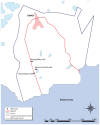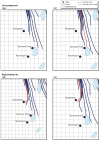Using residential history and groundwater modeling to examine drinking water exposure and breast cancer
- PMID: 20164002
- PMCID: PMC2898849
- DOI: 10.1289/ehp.0901547
Using residential history and groundwater modeling to examine drinking water exposure and breast cancer
Abstract
Background: Spatial analyses of case-control data have suggested a possible link between breast cancer and groundwater plumes in upper Cape Cod, Massachusetts.
Objective: We integrated residential histories, public water distribution systems, and groundwater modeling within geographic information systems (GIS) to examine the association between exposure to drinking water that has been contaminated by wastewater effluent and breast cancer.
Methods: Exposure was assessed from 1947 to 1993 for 638 breast cancer cases who were diagnosed from 1983 to 1993 and 842 controls; we took into account residential mobility and drinking water source. To estimate the historical impact of effluent on drinking water wells, we modified a modular three-dimensional finite-difference groundwater model (MODFLOW) from the U.S. Geological Survey. The analyses included latency and exposure duration.
Results: Wastewater effluent impacted the drinking water wells of study participants as early as 1966. For > 0-5 years of exposure (versus no exposure), associations were generally null. Adjusted odds ratios (AORs) for > 10 years of exposure were slightly increased, assuming latency periods of 0 or 10 years [AOR = 1.3; 95% confidence interval (CI), 0.9-1.9 and AOR = 1.6; 95% CI, 0.8-3.2, respectively]. Statistically significant associations were estimated for ever-exposed versus never-exposed women when a 20-year latency period was assumed (AOR = 1.9; 95% CI, 1.0-3.4). A sensitivity analysis that classified exposures assuming lower well-pumping rates showed similar results.
Conclusion: We investigated the hypothesis generated by earlier spatial analyses that exposure to drinking water contaminated by wastewater effluent may be associated with breast cancer. Using a detailed exposure assessment, we found an association with breast cancer that increased with longer latency and greater exposure duration.
Figures



Comment in
-
Residential history and groundwater modeling.Environ Health Perspect. 2010 Sep;118(9):a378; author reply a378-9. doi: 10.1289/ehp.1002444R. Environ Health Perspect. 2010. PMID: 20810346 Free PMC article. No abstract available.
Similar articles
-
Historical reconstruction of wastewater and land use impacts to groundwater used for public drinking water: exposure assessment using chemical data and GIS.J Expo Anal Environ Epidemiol. 2003 Sep;13(5):403-16. doi: 10.1038/sj.jea.7500291. J Expo Anal Environ Epidemiol. 2003. PMID: 12973368
-
Breast cancer risk and drinking water contaminated by wastewater: a case control study.Environ Health. 2006 Oct 6;5:28. doi: 10.1186/1476-069X-5-28. Environ Health. 2006. PMID: 17026759 Free PMC article.
-
Risk of breast cancer following exposure to tetrachloroethylene-contaminated drinking water in Cape Cod, Massachusetts: reanalysis of a case-control study using a modified exposure assessment.Environ Health. 2011 May 21;10:47. doi: 10.1186/1476-069X-10-47. Environ Health. 2011. PMID: 21600013 Free PMC article.
-
Long-term Neurotoxic Effects of Early-life Exposure to Tetrachloroethylene-contaminated Drinking Water.Ann Glob Health. 2016 Jan-Feb;82(1):169-79. doi: 10.1016/j.aogh.2016.01.013. Ann Glob Health. 2016. PMID: 27325074 Free PMC article. Review.
-
Total allowable concentrations of monomeric inorganic aluminum and hydrated aluminum silicates in drinking water.Crit Rev Toxicol. 2012 May;42(5):358-442. doi: 10.3109/10408444.2012.674101. Crit Rev Toxicol. 2012. PMID: 22512666 Review.
Cited by
-
A review of geospatial exposure models and approaches for health data integration.J Expo Sci Environ Epidemiol. 2025 Apr;35(2):131-148. doi: 10.1038/s41370-024-00712-8. Epub 2024 Sep 6. J Expo Sci Environ Epidemiol. 2025. PMID: 39251872 Free PMC article. Review.
-
Improving the power of chronic disease surveillance by incorporating residential history.Stat Med. 2011 Aug 15;30(18):2222-33. doi: 10.1002/sim.4272. Epub 2011 May 11. Stat Med. 2011. PMID: 21563208 Free PMC article.
-
Accuracy of commercially available residential histories for epidemiologic studies.Am J Epidemiol. 2011 Jan 15;173(2):236-43. doi: 10.1093/aje/kwq350. Epub 2010 Nov 17. Am J Epidemiol. 2011. PMID: 21084554 Free PMC article.
-
Residential history in cancer research: Utility of the annual billing ZIP code in the SEER-Medicare database and mobility among older women with breast cancer in the United States.SSM Popul Health. 2021 May 19;15:100823. doi: 10.1016/j.ssmph.2021.100823. eCollection 2021 Sep. SSM Popul Health. 2021. PMID: 34095430 Free PMC article.
-
Assessing exposure and health consequences of chemicals in drinking water: current state of knowledge and research needs.Environ Health Perspect. 2014 Mar;122(3):213-21. doi: 10.1289/ehp.1206229. Epub 2014 Jan 3. Environ Health Perspect. 2014. PMID: 24380896 Free PMC article. Review.
References
-
- Aschengrau A, Ozonoff D. Final report. Boston, MA: Massachusetts Department of Public Health; 1982. Upper Cape Cancer Incidence Study.
Publication types
MeSH terms
Substances
Grants and funding
LinkOut - more resources
Full Text Sources
Medical

